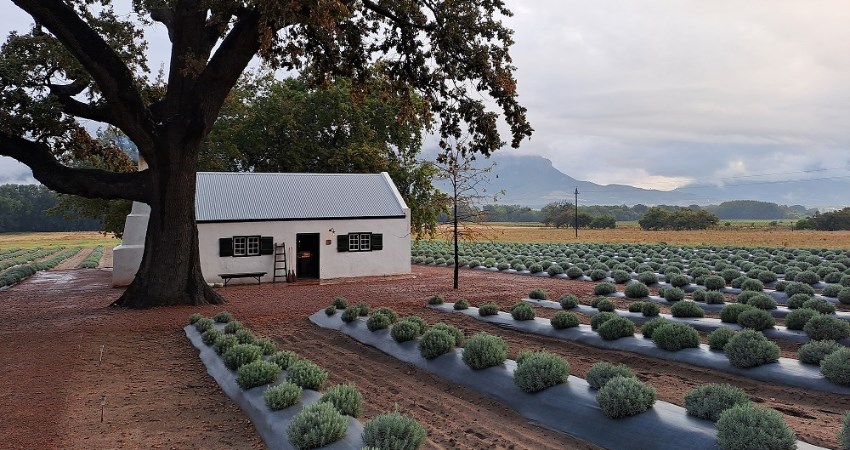
JAN Franschhoek first opened for a summer run with a firm start-finish date. Perhaps unsurprisingly, the venue was fully booked just days into the season and no doubt motivated the decision to make a return in September.
It was at the tail end of the first run that I had the chance to dine there. Most people will know that the South African chef rose to major acclaim when he claimed his first star from Europe’s Michelin Restaurant Guide. Now, a string of openings have taken place. They include Klein JAN at Tswalu Kalahari and the JAN Innovation Studio on Kloof Street, Cape Town.
Months prior to my own visit to JAN at La Motte, I encountered Jan-Hendrik’s name as a contributor to Jos Baker’s book, Preserving a House (2009). It’s a marvellous account of the time she – a writer and food critic – and husband, David, spent as owners of a historic, 18th century cottage on what was then the outskirts of Cape Town. The book includes the story of an intimate dinner the Bakers and friends conceptualised in the tradition of the earlier era. The menu featured dishes like pens-en-pootjies (tripe). Topsi Venter brought “ship’s cheese”, a variation of the delicacy as it would have matured on the ocean voyages of early explorers.
Jan-Hendrik had done the photography and styling for the book.
It was echoes of this style that hit me as I stepped into the JAN creation in the old Veepos building in Franschhoek. It had been raining and an overcast sky gave the normally picturesque valley an ominous mien.
I had Rocky Horror in my mind as drizzle fuzzed our windscreen and we arrive, directed by the invitation, at La Motte’s large, ornate gate. Beyond, a lane of trees shrouds a paved driveway. A man in a black suit peers through the slit of an open window and asks our business.
"We’re here to feed," I thought, but politer words escape. The gatekeeper checks a soggy list, smiles and the gates as if by magic, drawl open.
At the head of the driveway, a Cape Dutch manor sat framed by the last trees in a column. Parked alongside the stately building was a 1972 Volkswagen 1600 kombi, in baby-blue and white.
The manor was to be our waiting room. The dozen or so guests already there spread themselves across interleading drawing rooms, a glass of La Motte Cap Classique in hand. Soon, we’re ushered by kombi, across the road to the cottage beneath a large tree – the only landmarks amidst the surrounding plantation of lavender. Picturesque it is. There’s a twinkle of light from inside, and smoke rising from the stack.
Gentle candlelight and a few select spotlights break the shadows. Running the length of the room is a long table set with elegant glasses and crockery. On a far side, a table laden with nuts, fruits, and cheeses. A small fire burns in the hearth, warming a stockpot alongside. In the darkness above, herbs hang suspended from a low, reed ceiling; and, there’s a pumpkin in the window.
Chefs murmur in the kitchen, and there are the tones of a crooner soundtrack. In a corner of the dining room, a waiter pours warm water on our hands and offers soap. Then, we begin the meal with a refreshing cooler, made with blood orange, sparkling wine and lavender.
The menu is a blend of Afrikaans, English and French descriptions, and dishes.
It is without doubt, nostalgic theatre playing out. Nothing is as it seems, and tiny creations give way to galaxies of flavour. We launch into biltong lamingtons, braaibroodjie macarons, and bobotie jaffle choux.
Wines are from La Motte but also from JAN. The latter are made by Hagen Viljoen at Zewenwacht these days and comprise a red blend of Shiraz, Mourvedre and Grenache; and white, of Chenin blanc, Chardonnay, Roussane, Viognier, and Semillon.
A series of dishes follows the starters, each detailed on the menu, until we reach the mains. These are simply announced under the umbrella of kookkos – cooked food. Of course, there’s tongue with mustard sauce, slap haakskentjies (pickled onions), pumpkin fritters, pickled beetroot, and roast leg of lamb.
JAN’s red is then paired with pap brandsel (singed porridge), cheese and jams, and is followed by a tameletjie (toffee) meringue with Boekenhoutskloof Noble Late Harvest Semillon. The feast bids its farewell with moerkoffie (stove-top coffee) from pots that had bubbled away over the fire the whole evening, and mignardises (delicate desserts).
By close of evening, we leave like stepping out of the pages of a children’s book. I reminisce about lavish Sunday feasts at my grandparents’ house; the one’s prepared by a small unit of women. JAN’s food is splendid, but so are the memories it awakens. I’m sure Jan-Hendrik’s genius is not specifically in weaving magic from ingredients, but in his ability to rouse the universality of nostalgic meals.
To me, it’s an experience I easily recommend.
Behind us, the tree-shrouded cottage with the glow at its windows, fades and before soon, we’re off to bed.
Photos: Clifford Roberts